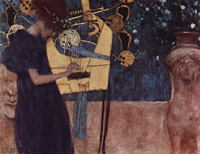period: Late- Post-Romantic
 The expressions "Late-Romantic" and "Post-Romantic" are relatively recent constructs used to delineate the later and/or "declining" phases of the Romantic period (after 1850), whose initial and overarching aspects are described on the Romantic page. By the mid-19th century, the Romantic impulses of subjective expression and organic unity had become fully internalized by most composers, leading to more pronounced applications of both. The ultimate personification of these Late-Romantic trends is surely Richard Wagner, whose operas and "Music Dramas" are largely defined by intense emotional expression, elaborate structural unity, and vast artistic scope - embodied in his term, Gesamskunstwerk (total or integrated artwork). Even composers who embraced differing conceptions of musical form and substance, most notably Johannes Brahms, were impelled by the same basic forces, and sought ever-tighter means to create structural cohesion in their music. As in earlier decades of the century, the realm of harmony formed a principal means of expanding expressive power; in the works of Wagner, Brahms, Anton Bruckner, Pyotr Tchaikovsky, Giuseppe Verdi, and others, the diatonic (simple) harmony of the Classical era was increasingly replaced by a chromatic (sophisticated) approach, eventually undermining the very integrity of Tonality - the harmonic language that had reigned since the late Baroque. Another dynamic trend of the period was the rise of musical Nationalism, where composers from countries outside the central nexus of Western music (Germany, Austria, France, Italy, and England) strove to explore and celebrate the folk traditions of their native lands within an art context - such as Edvard Grieg (Norway), Antonín Dvorák and Bedrich Smetana (Czechoslovakia), Jean Sibelius (Finland), Mikhail Glinka, Nicolay Rimsky-Korsakov, and Alexander Borodin (Russia), etc. - which in turned help to expand the overall musical language of the time, harmonically as well as rhythmically and in orchestration. By the closing decades of the 19th century, the developments noted above began to stretch to an extreme or "mannered" extend, as heard in the lengthy symphonies and orchestral works (tone poems, etc.) of Wagner's "successors", Gustav Mahler and Richard Strauss, as well as in vocal and instrumental works of other so-called "Post-Romantics", such as Alexander Scriabin, Sergey Rachmaninov, Giacomo Puccini, and Modest Mussorgsky - leading in many ways to a crisis of sorts, and thus to the kinds of experiments that defined the coming Impressionist and Modern eras.
The expressions "Late-Romantic" and "Post-Romantic" are relatively recent constructs used to delineate the later and/or "declining" phases of the Romantic period (after 1850), whose initial and overarching aspects are described on the Romantic page. By the mid-19th century, the Romantic impulses of subjective expression and organic unity had become fully internalized by most composers, leading to more pronounced applications of both. The ultimate personification of these Late-Romantic trends is surely Richard Wagner, whose operas and "Music Dramas" are largely defined by intense emotional expression, elaborate structural unity, and vast artistic scope - embodied in his term, Gesamskunstwerk (total or integrated artwork). Even composers who embraced differing conceptions of musical form and substance, most notably Johannes Brahms, were impelled by the same basic forces, and sought ever-tighter means to create structural cohesion in their music. As in earlier decades of the century, the realm of harmony formed a principal means of expanding expressive power; in the works of Wagner, Brahms, Anton Bruckner, Pyotr Tchaikovsky, Giuseppe Verdi, and others, the diatonic (simple) harmony of the Classical era was increasingly replaced by a chromatic (sophisticated) approach, eventually undermining the very integrity of Tonality - the harmonic language that had reigned since the late Baroque. Another dynamic trend of the period was the rise of musical Nationalism, where composers from countries outside the central nexus of Western music (Germany, Austria, France, Italy, and England) strove to explore and celebrate the folk traditions of their native lands within an art context - such as Edvard Grieg (Norway), Antonín Dvorák and Bedrich Smetana (Czechoslovakia), Jean Sibelius (Finland), Mikhail Glinka, Nicolay Rimsky-Korsakov, and Alexander Borodin (Russia), etc. - which in turned help to expand the overall musical language of the time, harmonically as well as rhythmically and in orchestration. By the closing decades of the 19th century, the developments noted above began to stretch to an extreme or "mannered" extend, as heard in the lengthy symphonies and orchestral works (tone poems, etc.) of Wagner's "successors", Gustav Mahler and Richard Strauss, as well as in vocal and instrumental works of other so-called "Post-Romantics", such as Alexander Scriabin, Sergey Rachmaninov, Giacomo Puccini, and Modest Mussorgsky - leading in many ways to a crisis of sorts, and thus to the kinds of experiments that defined the coming Impressionist and Modern eras.

Nolan Gasser, PhD
Artistic Director













